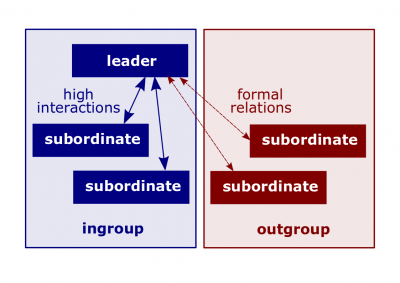Difference between revisions of "Leader-member exchange theory"
(Created page with "400px|thumb|right|[[Leader-member exchange theory]]Leader-member exchange theory (alternatively known as LMX theory; hereinafter, t...") |
|||
| Line 1: | Line 1: | ||
[[File:Leader-member-exchange.png|400px|thumb|right|[[Leader-member exchange theory]]]][[Leader-member exchange theory]] (alternatively known as [[LMX theory]]; hereinafter, the ''Theory'') is the [[leadership theory]] that says leaders create [[ingroup]]s and [[outgroup]]s and those in the [[ingroup]] will have higher performance ratings, less turnover, and greater [[job satisfaction]]. | [[File:Leader-member-exchange.png|400px|thumb|right|[[Leader-member exchange theory]]]][[Leader-member exchange theory]] (alternatively known as [[LMX theory]]; hereinafter, the ''Theory'') is the [[leadership theory]] that says leaders create [[ingroup]]s and [[outgroup]]s and those in the [[ingroup]] will have higher performance ratings, less turnover, and greater [[job satisfaction]]. | ||
| + | |||
| + | ==Definitions== | ||
| + | According to [[Organizational Behavior by Robbins and Judge (17th edition)]], | ||
| + | :[[Leader-member exchange theory]]. A theory that supports leaders' creation of [[ingroup]]s and [[outgroup]]s; subordinates with ingroup status will have higher performance ratings, less turnover, and greater [[job satisfaction]]. | ||
==Related coursework== | ==Related coursework== | ||
Revision as of 05:12, 26 November 2018
Leader-member exchange theory (alternatively known as LMX theory; hereinafter, the Theory) is the leadership theory that says leaders create ingroups and outgroups and those in the ingroup will have higher performance ratings, less turnover, and greater job satisfaction.
Definitions
According to Organizational Behavior by Robbins and Judge (17th edition),
- Leader-member exchange theory. A theory that supports leaders' creation of ingroups and outgroups; subordinates with ingroup status will have higher performance ratings, less turnover, and greater job satisfaction.
